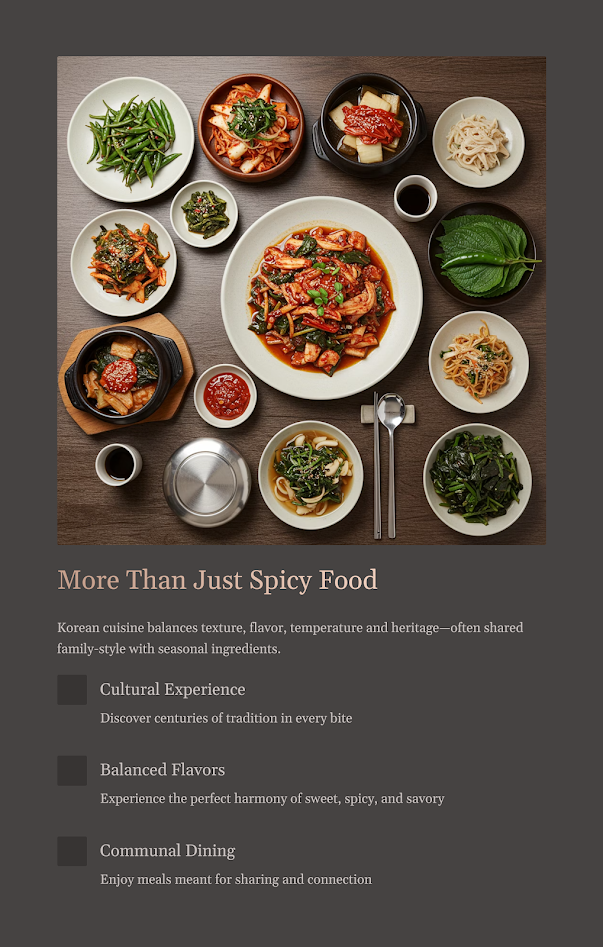Korean cuisine is bold, diverse, and deeply rooted in centuries of tradition.
As a Korean-American living in Korea, I’ve rediscovered classic dishes that every American should experience — not just for taste, but for culture.
What makes Korean food so memorable and worth trying?
Korean food is about more than spice and BBQ.
It’s a balance of texture, flavor, temperature, and heritage — often shared family-style and built around seasonal ingredients.
Here are 10 must-try dishes that give you a full-spectrum introduction to Korea’s culinary soul.
1. Kimchi – The Soul of Korean Flavor
Spicy, fermented cabbage might sound intimidating, but it’s Korea’s most iconic side dish for a reason.
Aged for days or months, kimchi brings tang, crunch, and a probiotic kick to every meal.
Once you develop a taste for it, you’ll crave it with everything — even pizza.
2. Samgyeopsal – Korean BBQ at Its Finest
Thick slices of pork belly grilled tableside with garlic, mushrooms, and kimchi.
Wrap it in lettuce with a dab of ssamjang sauce, and it’s heaven in a bite.
The hands-on, communal style makes this dish a social event as much as a meal.
3. Bibimbap – A Balanced Bowl of Color
A beautiful mix of rice, veggies, beef, and egg, topped with spicy gochujang.
Stir it all up and enjoy the harmony of flavors and textures.
Bibimbap is both satisfying and healthy — and a great intro dish for hesitant eaters.
4. Tteokbokki – Street Food With a Kick
Chewy rice cakes in a fiery red sauce made from gochujang, fish cakes, and scallions.
It’s sweet, spicy, and addictive — a favorite among students and late-night snackers alike.
5. Jjajangmyeon – Korean-Chinese Comfort Food
Black bean noodles served in a thick, savory sauce with diced pork and onions.
Affordable and filling, this dish is pure comfort food — think spaghetti, but with an umami twist.
6. Korean Fried Chicken – Crispy, Sweet, Spicy
Double-fried for that perfect crunch, Korean fried chicken is coated in sauces ranging from soy garlic to nuclear-level spicy.
Often enjoyed with beer (chimaek), it’s a must for wing lovers.
7. Sundubu-jjigae – Spicy Soft Tofu Stew
Served bubbling hot in a stone pot, this silken tofu soup comes with clams, shrimp, kimchi, or beef.
Crack an egg in just before eating and savor the warmth — especially great on cold days.
8. Banchan – The Art of Side Dishes
A Korean meal isn’t complete without a variety of side dishes, from marinated spinach to pickled radish.
Banchan isn’t just a garnish — it’s a reflection of balance, season, and hospitality.
9. Naengmyeon – Cold Noodles for Hot Days
Buckwheat noodles served in icy broth, often with slices of beef and a boiled egg.
It’s refreshing, tangy, and surprisingly satisfying — a summer tradition.
10. Gimbap – Korea’s Answer to Sushi
Rolled in seaweed and packed with rice, veggies, and meat, gimbap is the perfect grab-and-go snack.
Lighter than sushi and endlessly customizable — think of it as Korea’s ultimate lunch box food.
| Dish | Main Ingredient | Flavor Profile | Best Time to Eat |
|---|---|---|---|
| Kimchi | Napa cabbage | Tangy, spicy | Every meal |
| Samgyeopsal | Pork belly | Smoky, savory | Dinner with friends |
| Bibimbap | Mixed rice bowl | Balanced, spicy | Lunch or dinner |
| Tteokbokki | Rice cakes | Spicy, sweet | Street food hour |
| Jjajangmyeon | Black bean noodles | Savory, mild | Lazy weekend |
| Fried Chicken | Chicken | Crispy, saucy | Game night |
| Sundubu | Soft tofu stew | Spicy, warm | Cold weather |
| Banchan | Seasonal veggies | Salty, pickled | Every meal |
| Naengmyeon | Cold noodles | Refreshing, tangy | Summer |
| Gimbap | Seaweed rice rolls | Light, versatile | On-the-go meals |
#KoreanFood #MustTryKorea #Samgyeopsal #KimchiLove #KFoodJourney #AmericanInKorea












